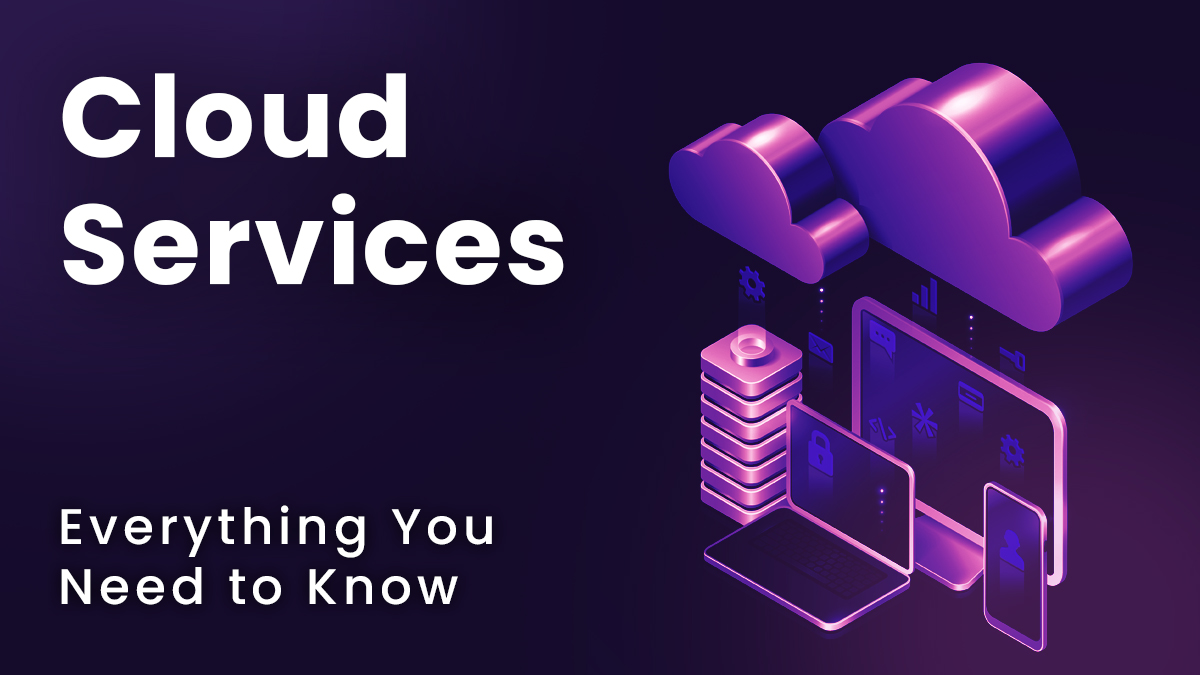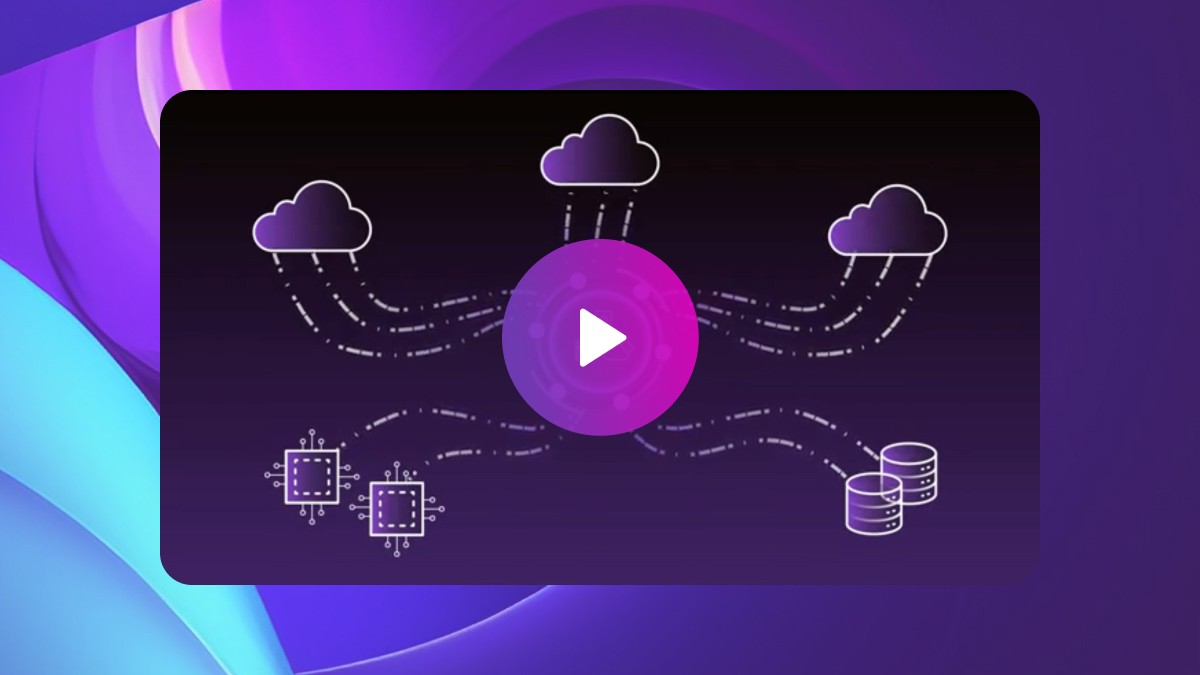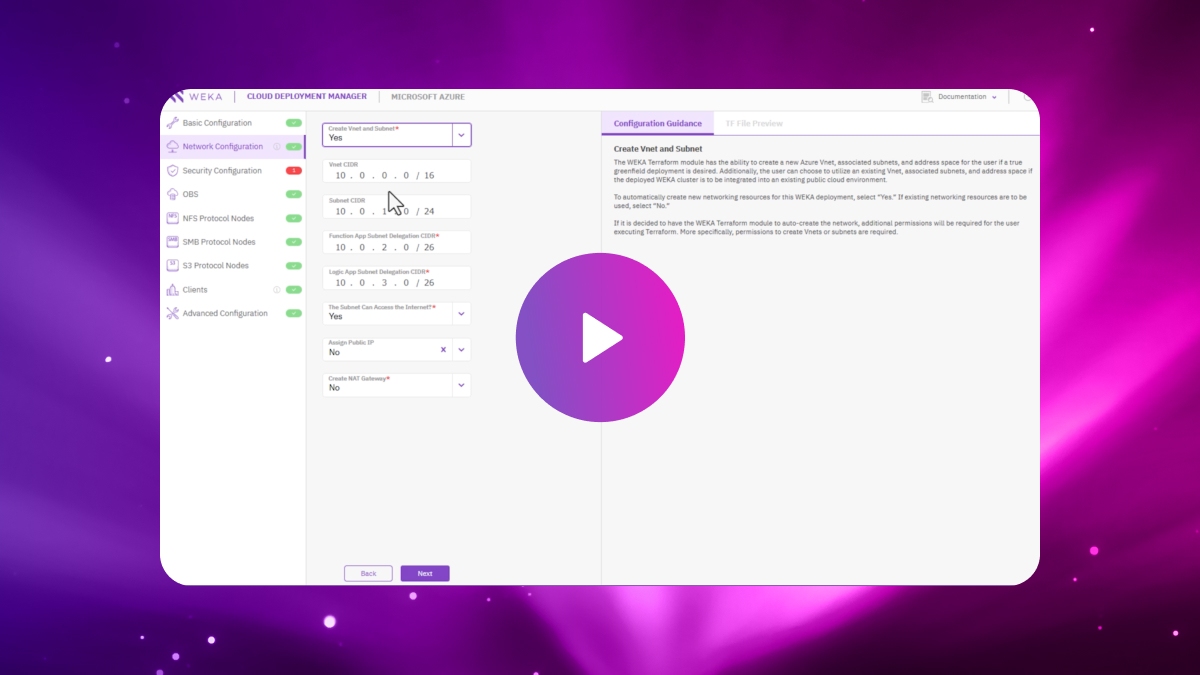Cloud Services: Everything You Need to Know

What are Cloud Services?
What are cloud computing services? Cloud services are computing resources and services including software, applications, storage, databases, and cloud infrastructure resources delivered online to customers.
What is a cloud service provider? Third-party providers called cloud service providers offer cloud computing services, typically via contract, for subscribers.
What is a cloud computing service used for? Services in cloud computing allow customers to access cloud service resources without buying or maintaining hardware and software. Users can access cloud services to collaborate, communicate, and run projects; process, share, and store data; and use cloud infrastructure without managing the operating system.
How Do Cloud Services Work?
Cloud services work by allowing users to access computing resources over the internet from a remote server. It is simple to learn how to use cloud services; ease of use and absence of user maintenance is among the main benefits of using the cloud.
Here is a brief summary of how cloud services work:
- Data storage. Users upload data to a remote server, where the provider saves it on virtual machines (VMs). Cloud providers often spread user data across multiple virtual machines in different data centers to ensure availability.
- Resource access. Users pay to access shared computing, storage, and networking resources.
- Communication. Resources communicate with each other across a network owned and managed by the cloud provider.
- Management. A control plane manages the underlying infrastructure (such as compute, networking, and storage).
- Shared. Cloud providers typically provide physical infrastructure that is shared across multiple customers or users, this is typically referred to as multitenant infrastructure.
- Security. Cloud services typically safeguard information with security and privacy features.Scalability. Cloud services allow users to scale resources up or down as needed, without buying and maintaining their own physical infrastructure.
Cloud Infrastructure Explained
What is cloud computing services infrastructure? Cloud services infrastructure is the hardware and software that together makes it possible to deliver services and resources over the internet.
Components of cloud infrastructure include storage such as data centers, servers, networking that allows for communication, and resources for security, virtualization, management, and computing.
The exact nature of cloud infrastructure depends on which cloud based deployment model the service uses.
Main Types of Cloud Deployment Models
What is a cloud deployment model? Deployment models of cloud computing deliver services in different ways based on where their infrastructure is located and who controls it.
What is a cloud deployment model? Deployment models of cloud computing deliver services in different ways based on where their infrastructure is located and who controls it.
What is a cloud service model? A service model for cloud deployment references the way the infrastructure and resources are organized to deliver a particular blend of cloud services.What are the main types of cloud services? The main cloud computing deployment models are public, private, hybrid, managed, and community clouds
Different Types of Cloud Service Providers Explained
What are different types of cloud services available from providers on the current market? Most standard types of cloud computing services are available from public, private, hybrid, managed, and community service providers, but based on the specific deployment model, the end result the user experiences is likely to have a different feel.
Public Cloud Providers
Public cloud providers offer a range of services, including computing power, storage, and various applications. Public cloud services are distinguished by several characteristics:
- Shared resources. Public cloud providers own, manage, and maintain resources that multiple users share.
- Pay-per-use. Customers typically pay only for cloud services they use, rather than buying hardware and software.
- Scalability. Public clouds offer on-demand resources that scale up or down to meet user needs.
- Reliability. Public cloud services span large networks of servers to ensure reliability.
- Accessibility. Users can access public cloud services over the internet or through dedicated connections.
What is private cloud services and how do private clouds differ from public clouds? External providers deliver public cloud resources as a fully managed service.
In a private cloud, one organization controls and maintains the infrastructure needed to deliver the IT resources. Private clouds can be hosted internally by a private company or remotely by a third party. They may be a good choice for organizations with business-critical operations or that need higher levels of control and privacy.
Key distinguishing features of private clouds include:
- Ownership. Private clouds deliver resources to the one organization in control of the cloud infrastructure—and that organization must also maintain the cloud. Public cloud providers offer fully managed cloud services to any customer.
- Compliance. Private clouds are well-suited for organizations with strict compliance and regulatory needs, while the shared environment of public clouds can be more challenging for meeting compliance requirements.
- Sharing. Private clouds and their resources are dedicated to a single organization. Public clouds are shared environments with each customer’s information isolated from others.
- Customization. Organizations can customize private cloud environments to meet specific business needs.
- Price. Private clouds are often more expensive than public clouds.
What are hybrid cloud services? Hybrid clouds combine some features of both public and private clouds. They utilize a private cloud but also one or more public cloud services to create an integrated cloud solution. Typically, the final offering is a managed solution incorporating a private segment.
Managed Cloud Services
What is managed cloud services? Are they public or private clouds? Managed cloud services are run by a third-party provider who is responsible for managing an organization’s cloud infrastructure.
Managed cloud services handle setup, configuration, maintenance, and security for their clients, so the user can focus on core business goals rather than technical details. This kind of service may encompass both public and private cloud environments; it is not a type of cloud, but a service model that can be used with various cloud types to achieve a range of organizational needs.
What are community cloud services and how do they differ from managed cloud services and public clouds?
A community cloud computing environment is generally shared by a group of organizations with similar needs, usually within the same industry. These users all access a cloud infrastructure for collaboration and data sharing while maintaining specific compliance requirements. A community cloud provides a more controlled, collaborative space for niche users compared to the broader accessibility of a public cloud and the full management of a managed cloud service.
What are the Different Types of Cloud Services?
How many types of cloud services are there, and what are the types of cloud computing services you are most likely to see on the current market?
There are five main types of cloud services that you are most likely to run across in today’s market:
- SaaS software as a service
- IaaS infrastructure as a service
- PaaS platform as a service
- FaaS function as a service
- GPUaaS GPU as a service
What is Software as a Service (SaaS)
What is SaaS? SaaS stands for software as a service, a cloud computing model that delivers access to software applications online. Some SaaS examples include:
- Email services such as Gmail or Outlook
- File sharing apps such as Dropbox or SharePoint
- Office platforms such as Microsoft 365 or Google Workspace
- Collaboration and communication apps such as Slack or Microsoft Teams
Many online tools or apps in wide use today are examples of SaaS applications.
Infrastructure as a Service (IaaS)
What is infrastructure as a service in cloud computing? Infrastructure as a Service (IaaS) is a cloud computing model that provides on-demand access to computing resources, such as networking, storage, databases, and servers. Some of the key examples of infrastructure as a service and reasons users favor this model include:
- Reduced maintenance. IaaS reduces or eliminates the maintenance on-premises data centers require.
- Lower costs. IaaS can help users save money on hardware costs.
- Scalable IT resources. IaaS allows businesses to scale their IT resources up and down based on demand.
- Improved business insights. IaaS can deliver real-time business insights.
Some specific infrastructure as a service examples on the market now include:
- Amazon Web Services (AWS) IaaS offerings include Amazon S3, Amazon Elastic Compute Cloud (Amazon EC2), and AWS Lambda.
- Microsoft Azure IaaS offerings include Azure VMs, VM Scale Sets, Azure Virtual Network, Azure Firewall, Traffic Manager, and Azure Backup.
- Google Compute Engine (GCE) offers VM and bare metal instances. GCE VMs can use a KVM hypervisor, and can run Linux or Windows operating systems.
- Oracle Cloud Infrastructure (OCI)
What is a Platform as a Service (PaaS)
What is platform as a service? The PaaS model is a platform for developing, running, and managing applications. PaaS and IaaS are similar, but with the platform as a service model the cloud service provider also provides services to build, test, and deploy new code and to run and manage applications. IaaS provides access to the underlying IT infrastructure, while PaaS gives developers an entire, scalable platform for building and managing applications. Users can bring their own code and deploy it, while the cloud provider manages the server and its scaling capabilities.
Some PaaS examples or use cases include rapid or multi-platform application development, microservice architectures, business process management, and real-time analytics applications.
Some function as a service examples include:
- AWS Elastic Beanstalk
- Google App Engine
- Microsoft Azure Web Apps
- Salesforce Lightning
Function as a Service (FaaS)
The function as a service (FaaS) cloud computing model allows developers to build and run applications without managing infrastructure. FaaS is a serverless computing model that typically offers a pay-as-you-go pricing model.
Some function as a service examples include:
- AWS Lambda supports functions written in C#, Go, Java, Node.js, PowerShell, Python, and Ruby
- Google Cloud Functions supports functions written in C#, Go, Java, Node.js, PHP, Python, and Ruby
- Microsoft Azure Functions supports functions written in C#, F#, Java, JavaScript, PowerShell, Python, and TypeScript
GPU as a Service (GPUaaS)
Recently a new set of cloud providers have emerged offering GPU as a Service. These providers focus on infrastructure offerings optimized for the GPU (Graphical Processing Unit) accelerated compute infrastructure that is required for generative AI model training and inference. GPU as a Service providers (also known as GPU Cloud, or sometimes “neoclouds”) focus on building extremely high performance networks, storage, and servers that are optimized for the unique performance and scale requirements associated with AI model training and inference.
Similar to Infrastructure as a Service providers, they offer compute on a pay as you go basis. Because they focus exclusively on the accelerated compute market, they are often able to offer more compelling price-performance options for customers focused on AI development.
Some GPU as a Service examples include:
- CoreWeave
- Lambda Labs
- Nexgen Cloud
- Denvr DataApplied Digital
Serverless Computing
What is serverless computing? Serverless computing is a cloud services model for developing and running applications that abstracts away the need for managing servers. In a serverless computing model developers write and deploy code to production, and the cloud provider handles everything else, including the provisioning, scaling, and maintenance of cloud infrastructure.
This model allows users to focus on core functionality and business logic. However, it comes with a loss of control, potential security issues arising from shared servers, and latency from “cold starts” after periods of inactivity
The Current Cloud Services Market
What are the largest cloud service providers? As of 2024, Amazon Web Services (AWS), Microsoft Azure, and Google Cloud Platform (GCP) are the three largest cloud service providers today. According to Synergy Research Group, these three comprise 66% of the worldwide cloud services market share for infrastructure, an increase from 63% the previous year.
What is the overall cloud services market size? As of 2024, the size of the cloud computing services market was estimated to be worth USD 675 billion, and is predicted to grow between 2025 and 2030 at a compound annual growth rate (CAGR) of 21.2%.
What are three popular cloud storage services? As of 2024, Amazon Web Services (AWS), Microsoft Azure, and Google Cloud Platform (GCP) also dominate cloud storage services. Per Fortune Business Insights, the value of the cloud storage market was estimated at USD 132billion in 2024.
Advantages and Disadvantages of Cloud Services
Why use cloud services? What are examples of cloud services in action, and how do they benefit users—or place them at risk? Cloud services allow users to access computing resources like storage, servers, and applications online. This enables access from anywhere, and is cost effective and scalable. However, it also presents data security risk and potential problems related to vendor lock-in.
Advantages of Cloud Services
What are the advantages of cloud services? There are a number of key benefits of cloud services:
- Reduced cost. Avoiding or eliminating the purchase and maintenance of hardware and software is more cost effective, and allows users to scale up or down to meet demand.
- Disaster recovery. Cloud services provide secure and redundant data storage that automatically retains data in multiple locations.
- Flexibility. Cloud services allow remote work from anywhere, which accommodates more users and saves money on workstations.
- Automatic updates. Cloud services centralize and automate updates so users keep software up to date with minimal effort.
- Quick application deployment. It’s easy to spin up new cloud computing instances quickly, and this allows developers to test new ideas and design applications without being limited by on-site hardware.
What are the benefits of cloud services relative to the drawbacks?
Disadvantages of Cloud Services
What are the risks of cloud services? Although there are mitigation strategies for each risk, there are a number of disadvantages of cloud services, including:
- Misconfiguration
- Data breaches
- Data loss or leakage
- Cost management
- Data sovereigntyCompliance issues
What is an example of cloud service risk mitigation? Each of these risks can be mitigated with a thoughtful mitigation plan, aligned to each risk. For example, to mitigate against data breaches and other security risks, organizations implement strong identity and access controls, such as multi-factor authentication (MFA). This best practice limits who can access sensitive data in the cloud, and grants users only the access they need to perform their job functions following the principle of least privilege. This helps prevent unauthorized access to critical information even if credentials are compromised.
FAQ: How to Choose a Cloud Service Provider
How safe are cloud services? Cloud computing is actually more secure overall than on-premises computing. Cloud providers often devote more extensive resources to securing data, and their infrastructure is designed with security in mind. However, cloud services can still be vulnerable to data breaches, unauthorized access, and other security threats.
When considering which cloud services to choose, look for a provider that complies with industry standards and offers strong security measures such as encryption and data redundancy for backup and disaster recovery. Some cloud services offer built-in security features, threat detection, and file auditing. Expect proof of consistent functionality and reliability.
How secure are cloud services for users with high compliance or regulatory demands? Cloud services can be highly secure for users with these kinds of demands. Look for a reputable provider that actively maintains compliance certifications relevant to your industry, such as GDPR, HIPAA, ISO 27001, PCI DSS, and SOC 2. This demonstrates their commitment to data protection and adherence to regulations.
How much do cloud services cost? A number of factors impact the cost of cloud services, including:
- The amount and type of storage used
- The bandwidth usage of infrastructure
- The type and consumption model of compute and database resources (per hour versus reserved versus savings plans)
- Maintenance and hardware update costs
- Region and availability
- Use cases and configuration
- Other charges such as exit and networking fees
Outlook on the Future of Cloud Services
What are cloud services used for now, and what is the future of cloud services? Here are a few trends in cloud services to be aware of right now:
- AI-driven cloud services. AI and machine learning will provide businesses with more powerful tools for automation and data analysis. The worldwide cloud AI market size was valued at USD 44.97 billion in 2022 and Grandview Research estimates it will grow at a CAGR of 39.6% from 2023 to 2030.
- Edge computing. With the continued rise of the Internet of Things (IoT), more companies are utilizing edge computing—data processing as close as possible to the data source. According to the market intelligence company International Data Corporation, edge computing investments will expand to almost USD 317 billion by 2026.
- Industry clouds. Cloud providers are offering industry-specific functionality and applications to streamline cloud migration. Industry clouds are gaining traction across all industry sectors, according to a report from Deloitte surveying 500 cloud leaders across industries. Gartner has also found that almost 39% of respondent organizations had begun to adopt industry cloud platforms.
- Hybrid and multi-cloud strategies. More businesses are adopting multi-cloud and hybrid strategies. An S&P Global Market Intelligence study found that 98% of enterprises either use or plan to use more than one cloud infrastructure provider. Similarly, 96% of respondents said they use or plan to use more than one cloud application provider.
How WEKA works with Cloud Services
WEKA provides a unified approach to data management in cloud computing environment that combines the economics and scale of the cloud with unmatched performance to turbocharge your demanding cloud workloads, and accelerate cloud project times. WEKA enables organizations to migrate their data-intensive workloads to the cloud easily and affordably. Workloads like generative AI, drug discovery, visual effect rendering, electronic design automation, AI inference, and many more require low latency and high throughput combined with the flexibility of the cloud. The WEKA Data Platform for cloud workflows makes it easy to leverage the best of what the cloud has to offer, no matter how you want to use it.
Run natively on any cloud: The WEKA Data Platform provides seamless integration with Amazon Web Services (AWS), Microsoft Azure, Google Cloud Platform (GCP), and Oracle Cloud Infrastructure (OCI) to give you a single, unified deployment option that performs consistently across edge, on-premises, hybrid cloud, and multi-cloud environments
Burst to the Cloud: The WEKA Data Platform makes it simple to maintain a usable copy of on-premises data in the cloud, where you can use elastic compute resources to run calculations and analyses and gain new insights.
Build agile cloud data pipelines: Enable every artist, researcher, and data scientist to seamlessly collaborate from any location using a single shared data set to deliver breakthrough results previously not possible in the cloud.
Move Data to the Cloud: The WEKA Data Platform’s Remote Backup feature sends snapshots of a filesystem – both full and incremental – including metadata, to an object store, so data can be restored on the original WEKA cluster or a new WEKA cluster of any size, on-premises and in the cloud.
Tier data in the cloud: Integrated cloud data management automatically and seamlessly moves data from the performance tier of flash-based storage to the native object storage capacity tier for massive scalability, all presented in a single namespace for the best economics at petascale.
Cloud workload management to migrate data between clouds: The WEKA Data Platform’s unique snap-to-object feature allows users to create a replica of production data and instantly push it to any S3 object store, both on-premises and in the cloud. The cloud copy can be used for cloud workload migration to another application cluster, or to provide a fast recovery point objective (RPO) service guarantee.
Contact WEKA today to learn more about how WEKA can improve your cloud workloads.





